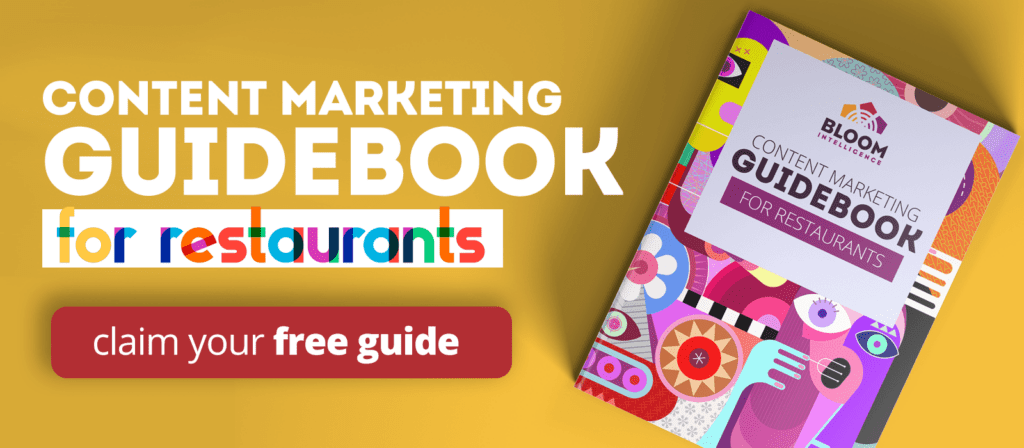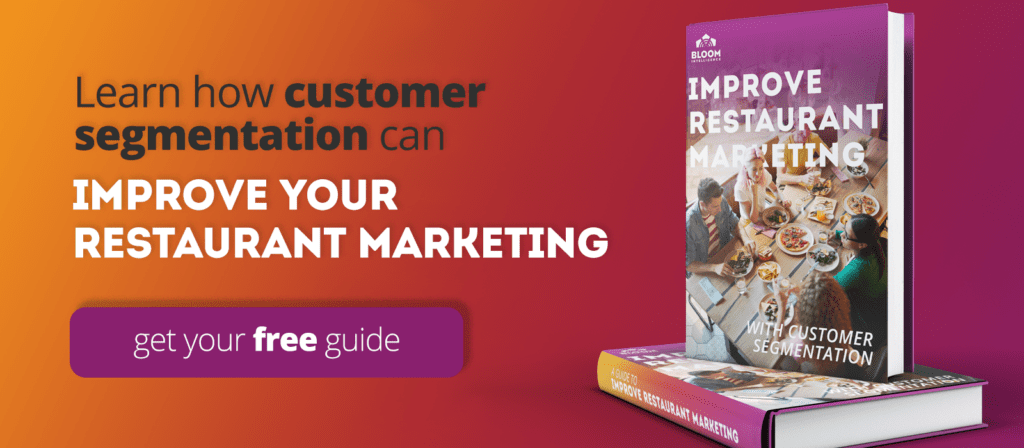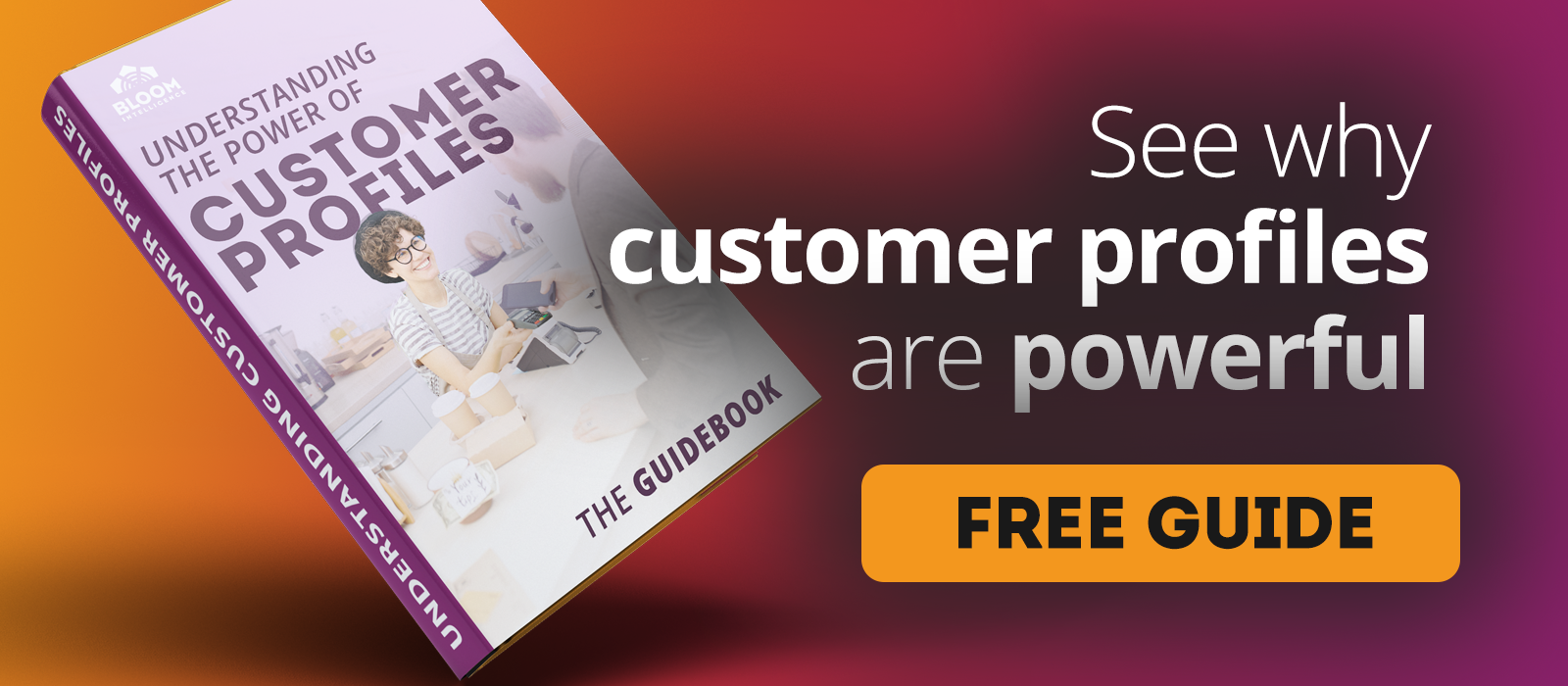21 Powerful Restaurant Email Marketing Tips and Information
Power Up Your Marketing with More Successful Restaurant Email Marketing Campaigns

Scroll to explore
Restaurant Email Marketing
 The best restaurant email marketing campaigns are personalized and are triggered by guest behavior. WiFi marketing and presence analytics allow retail and restaurant establishments to grow their customer databases quickly, personalize their guests’ experiences, and trigger email marketing campaigns based on their guests’ behavior.
The best restaurant email marketing campaigns are personalized and are triggered by guest behavior. WiFi marketing and presence analytics allow retail and restaurant establishments to grow their customer databases quickly, personalize their guests’ experiences, and trigger email marketing campaigns based on their guests’ behavior.
First, use your Bloom WiFi marketing platform to automatically build your customer profile database.
Without lifting a finger, you can collect 100,000’s of verified customer emails and profiles a year.
Once you build a large clean guest subscriber list, you don’t want to lose any of them because you are using generic or uninteresting messaging.
So, it is vital that you consider the steps below to help ensure your restaurant email marketing is as effective as possible.
Here are some great tips to help you draft the perfect email every time.
Restaurant Email Marketing Tips
1. Know Your Audience
First and foremost, to write effective email copy for your restaurant email marketing campaigns you must be intimately familiar with the audience that is going to receive the email.
Today’s consumers expect personalized, targeted messaging.
If you don’t know the audience, you have no way of knowing what type of message will pique their interest and compel them to engage.
Fortunately, with the help of Bloom’s WiFi marketing and analytics platform, this is exactly what you’re going to give them.
Having detailed presence analytics such as behavior patterns, customer profiles including names, emails, demographics, and zip codes will give you the ability to begin segmenting your customers into various buyers’ personas.
Personas are used by email marketing professionals worldwide to help conceptualize their target audiences and create the ideal target personas for which to create targeted, more personalized email marketing campaigns that are profitable.

When socializing with your guests, take the time to get to know them on a personal level.
What locations do they visit? How long is their dwell time when they visit? What are their concerns? What do they like and dislike? Are they a first-time visitor? What gets them excited about your establishment?
This kind of detailed insight cannot always be used and applied to a general, overarching audience.
However, speaking one-on-one with your customers allows you to start making useful generalizations that can be applied to your marketing messages for each persona.
2. Use Customer Segmentation for Restaurant Email Marketing
Using a WiFi marketing and analytics platform like Bloom Intelligence, you’ll immediately begin building a huge database of customer profiles.
Each profile contains all of the behavior and demographic data collected around each guest. Better yet, you’ll have their contact information, including their email address.
Bloom gives you the ability to sort and filter your list into various groups.
Essentially, you are segmenting the list into individual customer personas.
For instance, you might create a list of guests who only visit during your late-night happy hour and stay for at least an hour.
Conversely, you can create a list of women over 30 who only visit during lunchtime hours. The combinations are endless.
Using these two simple examples, it is easy to see that entirely different messages would appeal to each persona. Then you can save each list for future marketing campaigns.
Segmentation is a form of “content personalization.” This simply means a way to provide customers with content that is relevant to them. The goal is to provide engaging information that makes a customer want to return to your restaurant.
The Direct Marketing Association estimates that about 77 percent of all ROI from email marketing campaigns comes from segmentation.
Gathering information from your customers is the first step. For most restaurants, this will involve hiring a company that specializes in gathering data from guests and providing analytics services to brick-and-mortar companies.
You can segment guests in many ways. Some suggestions include:
- Geography
- Age
- Gender
- Past purchases
- Buying frequency
The key is to gather and analyze the right kinds of information about your customers and then target your email campaign to speak directly to them. It avoids sending the wrong message to the wrong people and increases the odds of sending the right message to the right people.
That’s a smart step in building a loyal customer base for your restaurant.
3. Decide on Email Marketing Smart Lists or Static Lists
Bloom Intelligence allows users to save their segmented customer lists in two different ways. They can be saved as a smart list, or as a static list.
Smart lists are great for automated marketing campaigns because you can create the list and it updates automatically whenever a guest meets – or no longer meets – the list criteria.
For instance, if you have a list of guests who have a dwell time of over 1 hour, then anytime one of them finally meets the 1-hour criteria, Bloom will add them to the list.
Or, if they fall underneath the 1-hour threshold, they will be removed from the list automatically.
Static lists, on the other hand, will never change once they are created. These lists are great for sending one-off emails for a very specific campaign.
For example, perhaps you want to target your patrons who have only visited once a month over the last 3 months.
You could send them an email persuading them to visit more often. You could even include an incentive, such as a free drink or dessert.
Whichever type of list you decide to use, Bloom will track its effectiveness all the way down to a guest walking back through your doors and redeeming an offer if one was included.
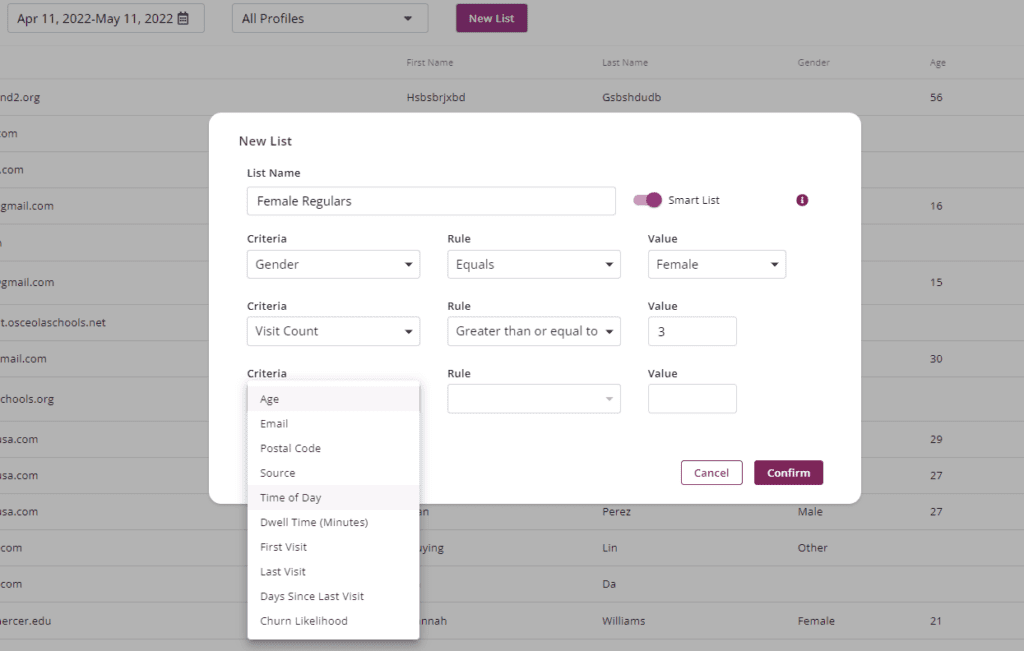
4. Determine Voice and Tone for Restaurant Email Marketing
Brands with a strong and consistent voice stand out from their competitors and create more of a personal connection with their guests.
This doesn’t only apply to restaurant email marketing.
Whenever a guest engages with your company, they should be spoken to in your established brand voice, whether it is on social media, in an email, or any of your marketing materials.
The trick is to find a common theme throughout the customer personas you have identified.
Then make sure the voice you decide to move forward with can speak to all of your personas effectively.
Here are some tips from Entrepreneur.com:
- Personify your brand. Think of your brand as an actual person. What would this person look and sound like? Is he or she young, old, serious, or funny?
- Brainstorm adjectives. Ask your team to think of three adjectives to describe your brand and culture, and use those as a jumping off point for the voice.
- Go where your audience is. Search online to see where your target audiences spend time, and examine how they talk to each other.
- Choose your ideal spokesperson. Select a celebrity you think would best represent your company and examine why you chose them. For instance, if you choose an esteemed actor, you may desire to sound distinguished. If you chose a comedian, you may want to be your customers’ funny friend.
- Read it aloud. When you’ve written some content, read it out loud to yourself or to an audience. Then, if any part sounds awkward, the voice isn’t right for your brand.
Once you’ve determined a brand voice, be consistent across all customer communication, especially restaurant email marketing messages.
As a result, your patrons will recognize you immediately and become more comfortable with your company.
5. Be Conversational
No matter the voice you decide to use, you should speak in that voice with a conversational tone.
You want to make sure your email sounds like it was written by a real person, with personality and a human touch.
Writing conversationally doesn’t mean to write like you talk. It means to write so that it doesn’t sound like writing.
- Use words that your customers use
- Inject your brand’s personality
- Try to engage them with questions
- Make it a two-way conversation
- Keep sentences short
- Do not write for your high-school English teacher
It’s not about sticking to English grammar, it’s about sending a message which co mmunicates ideas with clarity and personality.
In today’s world, consumers are generally looking for a reason to delete your email, not to open it.
Above all, a consistent and friendly message can help you get that email opened every time.
6. Personalize Your Email Message
According to Experian, personalized emails deliver a whopping 6x higher transaction rate.
And a DemandGen study showed that 53% of marketers say ongoing, personalized communication with existing customers can result in a significant revenue impact.
One of the easiest and most effective ways of personalizing your restaurant email marketing messages is to configure and implement triggered campaigns based on the guest’s behavior.
The Bloom WiFi analytics and marketing platform allows you to do this.
For instance, you can set a trigger to email an individual guest when they:
- Leave your establishment
- Are at-risk of churning
- Reach a loyalty milestone
- Leave a poor restaurant customer review or customer rating
- Reach the anniversary of their first visit
By sending an email when a specific behavior is observed, and then providing a conversational tone in your company voice, the customer will feel an immediate personal connection with your brand.
Additionally, the same can be said of sending the same type of message to a focused segment of your list.
Also, use “you” as opposed to “we” and “I” when writing your copy.
This makes the customer feel more like you are talking directly to them.
7. Optimize Emails for Mobile
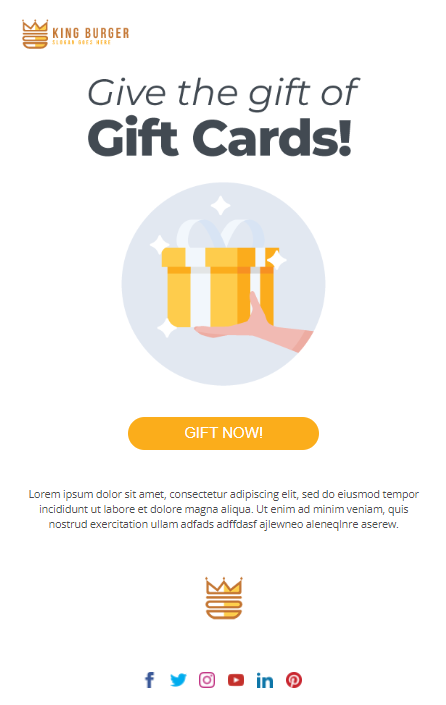
Email opens on mobile devices accounted for 46% of all email opens, followed by webmail opens at 35%, and desktop opens at 18%, according to a study by Litmus entitled, “Email Client Market Share Trends” (Jun 2018).
Moreover, it is expected that mobile email opens will only increase over time.
Because of this, it is important that your emails are optimized for mobile devices. If possible, use a responsive email template.
This means that the email content will adjust to “fit” on a smaller mobile screen.
You should also use smaller file sizes for your images. This will decrease the load time of the images, allowing for a much better user experience.
At the same time, you should increase the size of your font, links, and call-to-action buttons.
When ready to send, make sure to send a test email to yourself first. Make sure it appears well on desktops, laptops, tablets, and smartphones.
8. Proofread and Edit All Messaging
The worst feeling for a restaurant email marketer is to send an email and later realize there was a glaring copy mistake.
Even the best writers make mistakes.
Most writers will tell you that you shouldn’t proofread your own work.
It is simply too easy to overlook a typo or grammar error when you already know what the sentence is going to convey.
You should always have your emails proofread and edited by at least one other person. Just grab a team member or two and ask them to quickly read your email and provide feedback.
9. Monitor, Test, and Continuously Improve Your Restaurant Email Marketing
Never send an email or set up a triggered campaign and then forget about it.
For the best results, you should be consistently monitoring the performance of your email campaigns to recognize areas of possible improvement.
Once you have your baseline statistics for open rates, click-through rates, and unsubscribes, you can begin testing different variations of your emails to see if your variation performs better than the original (A/B split testing).
If the original gives you better rates than the variation, stop using the variation and try something different.
However, if the variation provides better rates than the original, then keep the variation and continue with another test.
As an example, some possible tests could be changing an image, changing button color, changing the subject line, or changing the overall tone of the email.
Whatever you decide to test, it’s important to remember that you should only test one change at a time.
If you make several changes and see a difference in your statistics, you won’t know exactly what it was that made the difference.
In other words, always test one variable at a time.
10. Start with Reliable Analytics
Any restaurant email marketing campaign should be built around solid, reliable, comprehensive data.
This data can be tough to acquire for brick-and-mortar establishments without a quality WiFi analytics and marketing platform, like Bloom Intelligence.
Bloom can give you the analytics you need to properly segment your customer base, develop accurate customer personas, and track the profitability of your email marketing strategy.
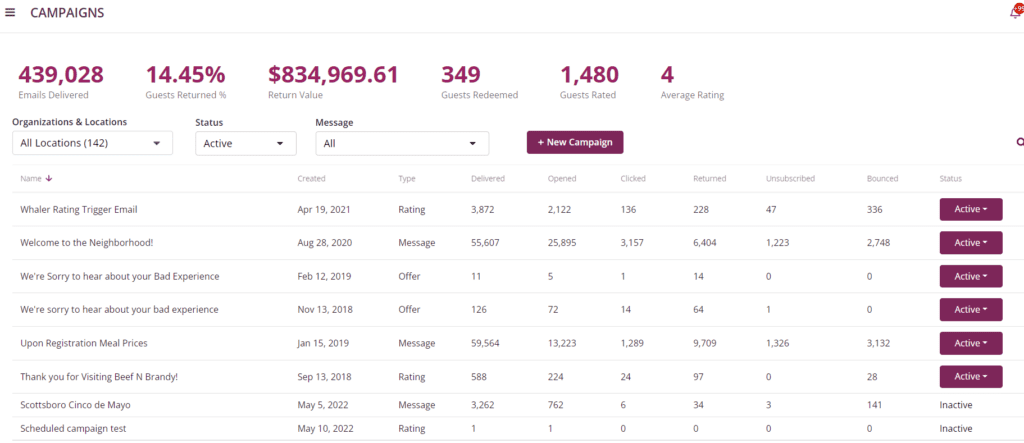
Then, you can use the automated marketing tools to quickly and easily set up the triggered marketing campaigns that give guests a more personal connection to your brand.
Or you can create segments of your customer database and send one-off or scheduled/recurring emails with messages, offers, or surveys based on your guests behavior.
Best of all, Bloom allows you to monitor each individual email you send out, giving you not only ROI on every campaign, but detailed statistics for testing and optimization.
Bloom’s WiFi marketing growth tools will supercharge your business! Now that’s just smart digital marketing. Set up a demo now to start growing your business!
11. Understand the Value of a Great Restaurant Email Marketing Strategy
An effective restaurant email marketing strategy can give restaurant marketers a solid competitive edge.
By discovering who your customers are, and what their interests involve, you can send emails that they will open, read, and engage with.
It is a great way to turn first-time visitors and other patrons into long-term, loyal customers.
Why email marketing?
First of all, it is by far the most cost-effective channel in which to reach customers with content, offers, and promotions.
In addition, the ROI from an effective campaign can bring back more ROI than any other digital marketing channel.
Consider these statistics:
- A study published on WebpageFX says the ROI of email marketing, in general, is $44 for every $1 spent. Compare that to Facebook which returns $4-$5 for every dollar spent. It’s about 10x more effective.
- The ROI of email marketing is 28.5% better than for direct mail.
- According to an ebook from Gourmet Marketing, 70% of customers want restaurants to send them coupons and are prepared to use them.
With an effective strategy, you can actually compete with those huge brands, keeping your seats full and your bottom line healthy!
Likewise, it can increase customer spend and loyalty, and help improve restaurant reputation management and branding.
If you are not currently using email as a marketing channel, or if your email campaigns are lacking in ROI, here are several tips and tricks to help you improve your email marketing results.
But remember, before executing any type of marketing campaign, one thing is essential – knowing your guests.
Why Collecting Customer Data is Crucial for Success
Many restaurant owners and operators send out emails to their customer database based on a hunch, or personal opinion of what will perform well.
Doing this can be detrimental to the ROI of your campaigns.
So, collecting customer data is a must so that you can personalize the messaging and timing of your email marketing. But, where can you get accurate and reliable data about your actual customer base?
Traditionally, customer data collection has been very expensive to obtain from 3rd-party companies.
In addition, the data you did obtain was a snapshot in time. If you wanted more current data, you had to pay for it.
For most small businesses, the expense outweighed the benefits.
Enter, WiFi analytics & WiFi marketing.
12. Use WiFi Analytics to Know Your Restaurant Guests
Knowing who your guests are and how they behave at your restaurant can allow you to create email messaging that will interest them, resulting in improved brand recognition and more return visits.
A WiFi marketing and analytics platform like Bloom Intelligence can give you this data for a very small portion of what 3rd-party companies charge.
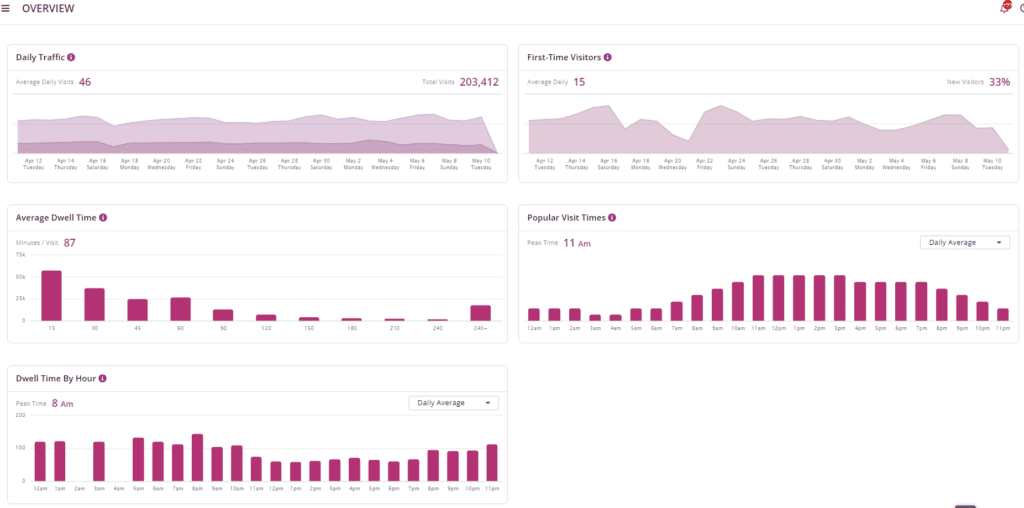
In addition, the data is updated in real-time. You will always know how your guests’ behavior is changing.
Even if they do not log into your WiFi, you can collect valuable data, such as:
- Customer foot traffic.
- First-time visitors.
- First-time visitor return rate.
- Overall customer return rate.
- Customer dwell times, and dwell times by the hour.
- Popular visit days and times, and more.
This data alone can give you insight into where your restaurant email marketing strategy should be aimed.
Likewise, once the campaign is launched, you can view customer behavior trends in real-time, allowing you to see the effectiveness of the campaign.
13. Passively Create Customer Profiles for Restaurant Email Marketing
Whenever a guest logs into your guest WiFi, Bloom creates a customer profile for that customer. In addition, they are added to your customer list.
Bloom integrates with all major email marketing providers such as Mailchimp, Constant Contact, and Emma.
In no time at all, you can passively build a very large list of customer profiles.
Likewise, with a large customer list, you can easily gain the campaign data necessary to optimize your campaigns over time.
In addition, using a technique called progressive profiling, you can build very rich, detailed customer profiles including other data such as:
- Age and birthday
- Gender
- Phone number
- Postal code
- All previous and current behavior data
You will also see whether or not the customer returns to your location and/or redeems any offer.
As already mentioned, perhaps the most valuable thing you can do with a robust customer list is to create customer segments and send different targeted, personalized emails to each of those segments.
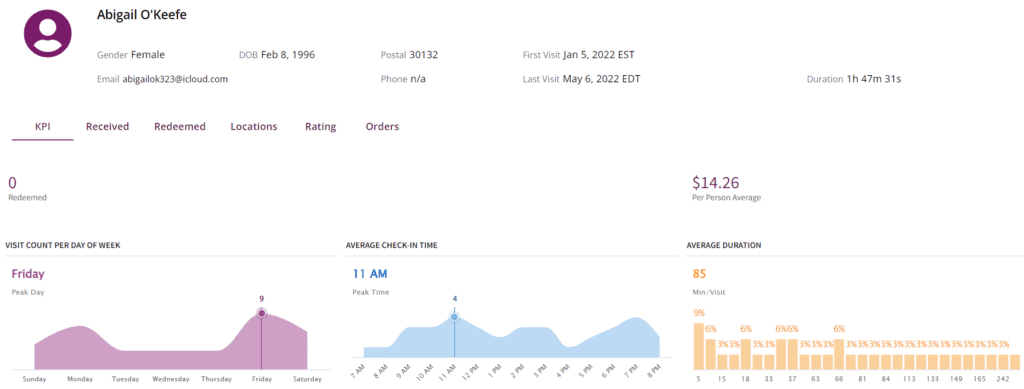
14. Use Segmentation and Personalization for Better Email Marketing
A 40-year-old father of three receives an email from a restaurant that is clearly aimed at attracting the 20-something hipster crowd.
What will he do with that email? Chances are, it’s getting deleted.
Likewise, odds are that future emails from that restaurant will be ignored, deleted without being opened and maybe even marked as spam.
Needless to say, those are all outcomes you want to avoid with your restaurant email marketing campaigns.
Email segmentation can help prevent those bad outcomes and increase the odds of creating some really good ones.
The Direct Marketing Association estimates that about 77 percent of all ROI from email marketing campaigns comes from segmentation.
Gathering information from your customers is the first step. For most restaurants, this will involve hiring a company that specializes in gathering data from customers and providing analytics services to brick-and-mortar companies.
You can segment customers in many ways. Some suggestions include:
- Geographic location
- Age
- Gender
- Past purchases
- Buying frequency
The key is to gather and analyze the right kinds of information about your customers and then target your email campaign to speak directly to them.
It avoids sending the wrong message to the wrong people and increases the odds of sending the right message to the right people.
That’s a smart step in building a loyal customer base for your restaurant.
Bloom makes it very easy to segment your customer base into these various groups and send targeted messages to each of them.
Better yet, you will see tangible ROI from each and every campaign you execute. More on that below.
15. Creating Targeted Emails for Your Restaurant Email Marketing Strategy
Now that you have created a customer database and various customer segments, you can begin crafting the perfect emails!
This is where your creativity and branding can really shine.
Let’s take a look at the most crucial elements of an effective email.
Email Subject Lines
No matter how powerfully written your email is, it won’t matter if the reader doesn’t open it.
You could be offering free meals for life, but if your subject line doesn’t compel the recipient to open, read and react, the email will have been sent in vain.
Many marketers create their email subject line as an afterthought, but in several ways, the subject line is much more important than the email itself.
Email subject lines are the first, and sometimes last impression you make on a potential reader. And they are the biggest factor in email open rates.
- Open rate by number of words in the subject line: 6-10 words (21%), 0-5 words (16%), 11-15 words (14%), 16-20 words (12%) (Business2Community)
- Emails containing personalization in the subject line are 22% more likely to be opened (Business2Community)
and, - Email is 40% better at converting people (in comparison to Facebook and Twitter) (The Annuta Group)
- 61% of subscribers/customers would like to receive promotional emails every week, 38% – more frequently. (Marketing Sherpa)
So, when crafting your email subject line, make sure to put careful thought into what you are going to use to compel the recipient to open the email.
The Email Body Content
A lot of restaurateurs will attempt to be warm and friendly while portraying their brand identity with their email copy.
While this is perfectly fine, it tends to make emails rather wordy.
Not many people are willing to read through a bunch of conversational fluff in order to get to the main point of the email.

Once you’ve drafted your email, go back through it and edit out all the filler words and phrases. And apart from an initial greeting, skip the small talk.
Likewise, if you have a grouping of details that need to be shared, use bullet points.
If you need to provide more information or details, include a link to the website page or other reference.
In addition, makes sure that your email content is responsive to mobile devices, meaning that it will open on a mobile device with larger font and smaller image file sizes.
A study by Adestra revealed that emails displayed incorrectly on mobile are likely to be deleted within three seconds.
Next, instead of using text links to outside sources, use buttons instead. They are easier to spot and provide a much better experience for mobile device users.
Finally, makes sure that you are using the best images you have. An image in an email has been shown to be one of the primary attention-grabbing elements.
Optimize Email Images
To really capture and engage your email recipients, make sure to include interesting imagery that:
- will capture their attention.
- is relevant to the content.
- will not slow downloading time.
Correctly optimizing your emails is paramount in gaining the attention and engagement of your subscribers.
First, choose images that relate to the email message. For instance, do not use an image of your wait staff when sending an email about a new menu item.
Instead, use an image of the item itself, or an image of customers enjoying it.
Whatever image you decide to use, make sure it is not blurry or pixelated. Use the sharpest images optimized for file size and visual clarity.
With the right subject line, a compelling message, and great imagery, your segmented email marketing campaigns have the ability to bring in more and more loyal customers with every message you send.
16. Test Email Optimization
Once you have created your campaign, it is important not to rest on your laurels.
Every message you send should be optimized and tested after baseline data is captured.
The best way to optimize and test your restaurant email marketing strategy is through a process called A/B split testing, or AB testing.
To clarify, AB testing involves taking an email message and creating a variation of the message with one major change made, such as:
- Subject line change
- Image change
- Button color change
- Messaging change
Then you can send one message to half of the recipients, and the variation to the other half.
Or, after gathering enough baseline data, you can begin sending the new variation to all campaign recipients.
Then, you measure the data to see which variation performed the best. At that point, you will accept the winner as the new campaign email and start the AB test process again.
Likewise, you can use the information you gathered to apply to other campaigns for AB testing.
The important thing to remember is to only test one thing at a time.
For instance, if you made multiple changes and realized that the email with the change didn’t perform well, you will not know which change caused the decrease in performance.
Over time, your emails will become more and more optimized, resulting in greater ROI.

17. Measure Email Marketing Results
Of course, as a business professional, you will want to measure the ROI of each campaign you execute.
In the past, this was very difficult for offline, brick-and-mortar marketers.
Fortunately, using a WiFi marketing and analytics platform for your restaurant email marketing strategy, you can measure accurate, tangible results.
With Bloom, for every campaign you launch, depending on the type of campaign, you will be able to see:
- Total emails sent
- Number of emails opened
- Total email clicks
- Coupon redemptions
- Number of customers who returned
- The value of customers who returned
- Ratings and reviews given
- Much more
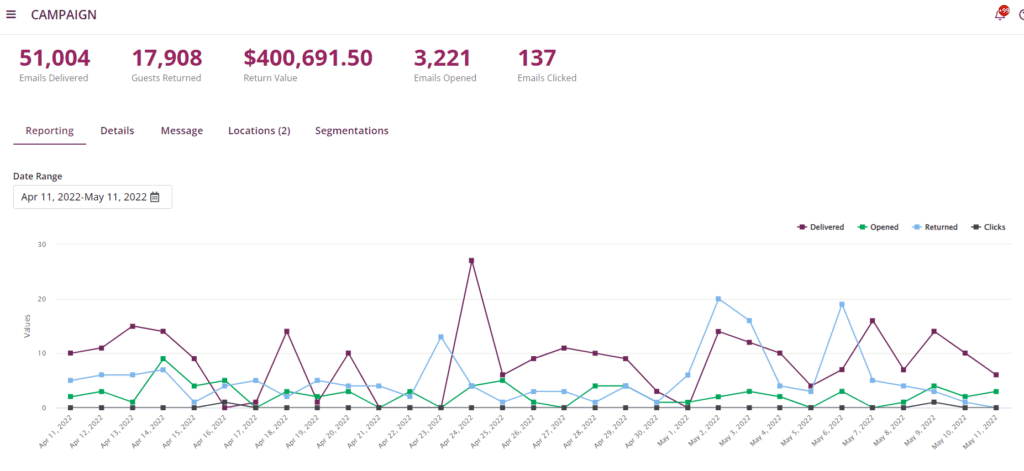
With these kinds of statistics, it becomes easy to understand whether or not a specific campaign is bringing you the ROI required to extend the life of the campaign.
Or, you can quickly discover campaigns that are simply not performing.
Based upon the results, you can optimize your restaurant email marketing strategy, gaining a competitive edge in today’s highly-competitive marketplace.
Restaurant Email Marketing: Personalization and Segmentation Tips
Personalization of restaurant email marketing messages is crucial to winning over today’s savvy consumers.
Personalization refers to using customer data to create much more effective email content because it can be tailored for each individual or each customer persona.
Using personalized messaging has been proven to improve open rates and generate more revenue because it allows restaurant marketing professionals to create more relevant content that will more effectively pique the interest of the consumer.
By collecting guest data through your WiFi access points, and grouping those customers into separate lists, marketers can avoid sending out a single mass message in hopes that it resonates well with at least some of the audience.
Instead, they can focus on sending highly targeted messages to each customer segment, increasing open rates and encouraging more engagement.
How to Collect Individual Customer Data
To execute an effective personalized restaurant email marketing campaign, you’ll need to have comprehensive data about your individual customers. There are various ways in which to collect customer data, but most are either expensive or take a great deal of time and energy.
The only way to gather enough data to effectively create a personalized campaign is to use a quality WiFi Analytics platform. Using WiFi technology, you’ll be able to capture data directly from your customers when they log into your WiFi access point. This will allow you to passively gather the necessary individual customer information required for proper personalization.
Using progressive profiling, data such as name, email address, phone number, age, gender, birthday, and other information is entered by the customer each time they log back into your WiFi.
In addition to all of this demographic information, the WiFi analytics platform also tracks the physical behavior of your customers, logging things such as dwell times, repeat visits, coupon redemption, days of the week, and hours of the day they have visited.
With this kind of thorough and reliable data, marketers can begin using it to build powerful, data-driven targeted restaurant email marketing campaigns.
Using Data to Build Personalized Marketing Messages
According to research from Salesforce, the world’s #1 customer relationship management platform, data targeting and segmenting were used 51% more by overperforming businesses than those who were underperforming. This makes perfect sense when thinking about today’s consumers. They expect personalized messaging and they know when they’re receiving a simple generic mass-marketing message.
The simplest way to start creating personalized campaigns is to make your customer profile data filterable. This will allow you to start building segments of specific customers based on their demographics and behavior data.
Email Segmentation for Restaurant Marketing
It is important to be able to save these segmented lists. Then, you won’t have to build them each time you want to send out a message.
Some examples of segmented lists might include:
- Women over 30 who visited on Mother’s Day of last year
- Any customer who has visited more than x times
- Customers whose average dwell time is under 20 minutes
- Men below 45 years old who have only visited your establishment once
- Women/Men who only visit at lunchtime
As you can imagine, these specific audiences would likely respond best to entirely different marketing messages. Being able to segment your customer list allows this to happen.
While building these lists, you’ll need to be brainstorming about how to effectively engage these groups. As you go through this process, ask yourself and your team members these questions:
- What kind of action do I want this customer to take?
- What is the best way to reach this customer?
- Which kind of deals or promotions would interest this customer?
- What kind of deals and promotions would NOT interest this customer?
- What new products or services might engage this customer?
- Why do they need what I offer? What are this customer’s pain points?
- How can I attract and engage more customers like this?
- What type of imagery would engage this customer?
Remember to Always Be Testing
Now that you have your customer segments properly defined, and you have an idea of the marketing messages and promotions you want to send to them, it’s time to get started.
When you send your marketing message to each list, monitor the ROI of each campaign.
As initial results come in, analyze the results and keep them documented in your platform. The next time you send a message to each group, you’ll want to make a small change to the message.
You should only make a single change to the message while testing. Send the message and compare its results to the original message.
If the results are not as good as the original, go back to your original message and test a different aspect of the message. If results are better, keep the change and continue testing and optimizing over time.
Also, don’t forget that you’re not just targeting current customers. You should also be seeking out new lookalike prospects online and targeting them in an effective manner using the data you’ve collected.
These prospects should have a higher probability of becoming new customers. They can provide a more cost-effective means of acquiring new customers.
Personalizing your restaurant email marketing messages with reliable customer data has been proven as an effective way to deliver relevant and engaging marketing content to your customers. This adds value to their experience and can quickly improve your open rates and subsequent revenue.
Using a WiFi marketing and analytics platform to collect a large volume of the right data, personalizing your marketing campaigns has never been easier. You’ll feel confident as you make solid data-driven decisions. You’ll drive company growth and build a much larger base of loyal customers.
With the amount of competition out there, email marketing can give you a strong competitive advantage and ensure lasting success.
Discover Bloom Intelligence
Email marketing offers excellent ROI potential if executed properly.
You need a plan, it must be executed in accordance with best practices, and you need to see and understand the numbers on the backend.
Bloom Intelligence offers WiFi marketing and analytics solutions tailored to drive subscriptions and customer engagement while measuring ROI on every campaign.
Repeat customers mean repeat profits. Start getting them today!
In today’s competitive environment, we can give you the competitive edge for success! Let us show you how.
- Call 727-877-8181
- Email us at sales@bloomintelligence.com
- Schedule a Demo
SAVE TIME, INCREASE CUSTOMER LIFETIME VALUES, CREATE NEW CUSTOMERS
What our happy customers
are saying
“SaaS that covered so many bases for us instead of having to use multiple software products. Bloom Intelligence has simplified our responses to reviews, customer feedback, and more. I highly recommend Bloom Intelligence.”
Robert Sanderson
“Bloom Intelligence really is a step ahead in terms of marketing software and metrics. Their product is reliable, fast and innovative and has helped the company I work for really grow.”
John Marchetti
“Working with Bloom Intelligence has been amazing. They assist you every step of the way and work with you hand in hand to make sure you are optimizing your advertising potential. We are excited to use this tool to help learn more about our customers so that we can personally engage with them and understand our strengths/weaknesses.”
Ariel Ramirez
“In these challenging times, it has been a pleasure working with Bloom Intelligence to help facilitate our service offering to our clients. They were extremely responsive and provided support to mitigate risk and minimize revenue loss. Great partner!”
Stefan Kim
“We’re extremely pleased with the wealth of customer data that we’re able to gather, at a very attractive price. In addition, we’re able to communicate our new product promotions by using the landing page as a digital billboard. A “no-brainer” for anyone working with limited Marketing $$.”
Bob Cross, Vice President of Operations
Bloom CRM Database FAQs
What Does CRM Stand For?
CRM stands for Customer Relationship Management database. To summarize, a CRM database is a collection of guest data grouped into customer profiles. So, a CRM can be used to understand your customer base, and for segmented, targeted marketing campaigns that can be tracked for accurate attribution.
What is a CRM Database?
A CRM Database is a digital collection of individual guest information grouped into customer profiles. Likewise, the database consists of detailed guest data such as names, behavior data, demographics, addresses, zip codes, emails, and phone numbers. As a result, these profiles are used to track communication and to remarket to guests.
What are Examples of a CRM Database?
An example of a CRM database for offline companies is the Bloom Intelligence CRM database. For example, using guest WiFi access points & guest WiFi landing pages, the platform collects guest behavior data, whether they log into WiFi or not, and builds detailed customer profiles for marketing and attribution. By comparison, other popular CRM’s include Salesforce, Microsoft Dynamic, and Hubspot.
How Do I Create a CRM Database?
For restaurant and retail locations, the easiest and best way to create a CRM database is to use your WiFi access points, Guest WiFi landing page, website widgets, and API’s to collect guest information and behavior data. Then, once configured, your guest data is collected and cleaned automatically.
The Power of a Restaurant CRM Database

Optimize retail &
business operations

Track attribution of
customer campaigns

Trigger marketing
campaigns based on
marketing presence

Measure the health
of corporate & franchisee
locations

Compare locations or
group of locations to
quickly identify opportunities
or threats
Are you ready to grow
your business with a
restaurant CRM database and
Wifi marketing automation?
If so, find out how Bloom Intelligence’s WiFi analytics
& marketing platform measures offline guest
behavior and builds guest loyalty.
So, it’s time to start leveraging your guest WiFi to gain
a competitive edge. Then watch your profits grow.




